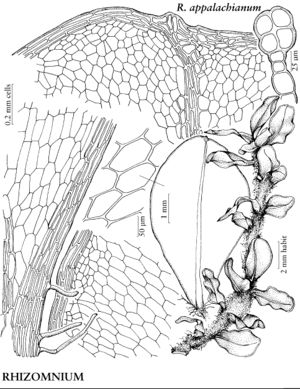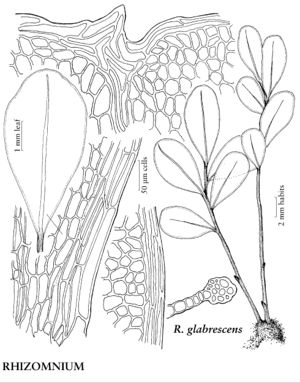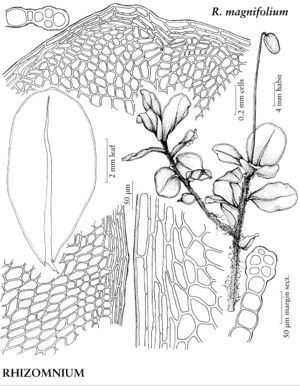Rhizomnium
Ann. Bot. Fenn. 5: 142. 1968.
| Taxon | Illustrator ⠉ | |
|---|---|---|
 | Rhizomnium appalachianum | Patricia M. Eckel |
 | Rhizomnium glabrescens | Patricia M. Eckel |
 | Rhizomnium magnifolium | Patricia M. Eckel |
| ... further results | ||
Plants 1–8 (–12) cm, in tufts or mats. Stems red or reddish-brown, becoming darker, sometimes black when old, usually erect, rarely sinuate at maturity or sterile stems sometimes arching, usually simple, not dendroid; rhizoids brown, macronemata often matted proximally, mainly restricted to stem-bases distally, not in longitudinal rows, micronemata present or absent. Leaves green, dark green, or occasionally reddish, reddish-brown, or yellow-green, somewhat contorted when dry, erect-spreading and flat, sometimes undulate when moist, obovate, elliptic, or rarely ± orbicular, 1–7 (–13) mm; base narrowly short to long-decurrent; margins plane, green, reddish, or brown, rarely blackish with age, 1–4-stratose, entire; apex usually rounded, occasionally retuse or emarginate, sometimes apiculate; costa ending well below apex (to about 7/8 leaf length and often 2-fid distally), subpercurrent, or percurrent, distal abaxial surface smooth; medial laminal cells elongate, sometimes short-elongate or ± isodiametric, 35–180 µm, sometimes in weakly developed diagonal rows, usually collenchymatous, walls pitted or not; marginal cells differentiated, linear, rhomboidal, or rectangular, in (1–) 2–3 (–6) rows. Specialized asexual reproduction absent (sometimes by green protonematous rhizoids in R. punctatum). Sexual condition dioicous or synoicous. Seta single, reddish-brown, occasionally orange, often pale, 1–5 cm, straight to somewhat flexuose. Capsule horizontal to pendent, yellow or yellowish-brown, elliptic, ovate, subglobose, oblong, or cylindric, 1–4.5 mm; operculum conic, conic-apiculate, or conic-rostrate; exostome yellow or brown when mature; endostome yellow or yellowish-brown, segments free. Spores 25–50 µm.
Distribution
Nearly worldwide, mostly Northern Hemisphere
Discussion
Species 13 (8 in the flora).
The presence or absence of micronemata along mature stems is essential when separating species in Rhizomnium (micronemata are smaller, less branched and paler than macronemata, mainly restricted to leaf or branch bases distally). In most instances, micronemata are easy to observe, but growing stems often lack them, particularly in plants of R. magnifolium, so this character should be assessed using older stems, which are sometimes buried in the litter. Occasionally, patches of weakly developed plants of R. gracile have nearly naked stems requiring close inspection of a number of stems in order to observe the micronemata or micronemata initials. Five species of Rhizomnium are circumtemperate or circumboreal, one species is circumarctic, and two are endemic to the flora area.
Selected References
None.
Lower Taxa
Key
| 1 | Micronemata present on mature stems | > 2 |
| 1 | Micronemata absent from mature stems | > 5 |
| 2 | Plants (2-)3-8(-12) cm; leaves 4-9(-13) mm; medial laminal cells (50-)80-180(-210)µm; marginal cells linear; margins usually 2-stratose | > 3 |
| 2 | Plants 1-6(-9) cm; leaves 1.5-6(-7) mm; medial laminal cells 35-90(-100) µm; marginal cells mainly rhomboidal or ± rectangular; margins 1-stratose | > 4 |
| 3 | Medial laminal cells (50-)100-180(-210) µm, not or weakly collenchymatous; costae percurrent, rarely subpercurrent or ending well before apex; margins reddish, brown, rarely green, or blackish with age; apices bluntly apiculate. | Rhizomnium appalachianum |
| 3 | Medial laminal cells (55-)80-100(-130) µm, weakly collenchymatous; costae ending well before apex, subpercurrent, or percurrent; margins green or sometimes reddish; apices rarely weakly apiculate. | Rhizomnium magnifolium |
| 4 | Plants 1-3(-5) cm; leaves 1.5-3(-4) mm, obovate or orbicular; sexual condition dioicous. | Rhizomnium gracile |
| 4 | Plants (2-)3-6(-9) cm; leaves 3-6(-7) mm, broadly obovate, elliptic, or rarely orbicular; sexual condition synoicous. | Rhizomnium pseudopunctatum |
| 5 | Leaf margins 1-stratose; leaves (1-)1.8-2.4(-3.8) mm, usually reddish to reddish brown; arctic-alpine. | Rhizomnium andrewsianum |
| 5 | Leaf margins (1-)2-4-stratose; leaves (2-)3-6(-9) mm, light to dark green, occasionally reddish at margins; more temperate regions | > 6 |
| 6 | Plants (1-)2-5 cm; leaves often ± orbicular; apices rarely short-apiculate; medial laminal cell walls with broad central pits. | Rhizomnium nudum |
| 6 | Plants 1-3(-5) cm; leaves obovate or elliptic; apices short-mucronate or apiculate; medial laminal cell walls lacking broad central pits | > 7 |
| 7 | Leaves obovate or elliptic, (2.5-)4.5-6 mm; medial laminal cells short-elongate, sometimes elongate or ± isodiametric, (35-)45-60(-70) µm; setae (2-)3-5 cm; w North America. | Rhizomnium glabrescens |
| 7 | Leaves broadly obovate or elliptic, (2-)3-5(-7) mm; medial laminal cells short-elongate or elongate, (50-)65-100(-120) µm; setae 1.5-3.5 cm; widespread. | Rhizomnium punctatum |